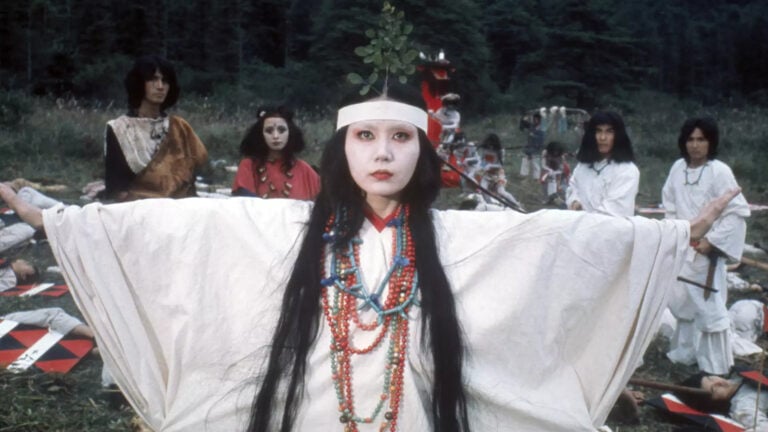
Off the coast of the great Han dynasty, a civilization dwelled upon the peaks of a volcanic island chain. Lying to the southeast of the majestic Tai-fang prefecture, these lands once brimmed with the life of over a hundred distinct communities.
Emissaries from the islands graced the imperial Court of the Han dynasty. Yet, as time passed, the interactions dwindled to a mere thirty communities, maintaining their connections through the threads of envoys and the meticulous works of scribes.
For decades, the horizon was painted with turmoil and conflict. Amidst this storm, an unspoken consensus emerged among the people, an agreement forged by whispers and gazes. And so, a woman ascended the throne of power.
Himiko was the name that echoed through the land, followed by rumors of magic and sorcery. A paradox of age, for time, had etched its marks upon her, yet the bonds of matrimony eluded her grasp. Himiko of Wa, a name etched into history’s scroll, a ruler whose story dances between the realms of fact and legend.
In this article, I would like to explore the mysterious Himiko and explain who she might have been and why she is so important in Japanese history.

Yukihiko Yasuda “Himiko” (Shiga Prefectural Museum of Modern Art)
Who were the Yamatai People?
During those times, the expanse we now recognize as Nihon, or Japan, was called Wa 倭—a land marked by its unique character within the annals of Chinese records. “Wakoku,” a term translating to “dwarf country,” was used in historical Chinese records, particularly in texts like the “Records of the Three Kingdoms” (Sanguozhi), to describe the people of the Japanese islands during the 2nd and 3rd centuries CE.
However, another term, “Yamatai,” is often linked to the political entity these communities might have been part of, which Himiko is said to have ruled over. However, the historical details surrounding the Yamatai people and the Yamatai Kingdom remain unclear and shrouded in mystery due to the scarcity of concrete historical records from that time.
Much of what is known about them comes from accounts recorded in Chinese texts, particularly the “Records of the Three Kingdoms” (Sanguozhi), which mention Himiko and her interactions with emissaries from the Chinese Wei Kingdom.

Later Han period historical map (from the National Diet Library Digital Collection)
At that time, the Yamatai people had no written script of their own as kanji wouldn’t be introduced into the Japanese isles until the fifth century (see The Magic of Kanji for the history of kanji in Japan). Instead, the story unfolds through the accounts scripted by the hands of China and Korea.
Records of Himiko in China
The “Records of the Three Kingdoms” (Sanguozhi) is a historical text by Chen Shou in China during the third century CE. It is a comprehensive account of the events and political history of the late Eastern Han dynasty and the Three Kingdoms period. The text covers the period from the Yellow Turban Rebellion in 184 CE to the reunification of China under the Jin dynasty in 280 CE.
The Three Kingdoms period was marked by political instability and warfare as various warlords and factions vied for control of China. The primary players during this time were the three major states: Wei, Shu, and Wu. The “Records of the Three Kingdoms” provides detailed biographies of key figures, descriptions of battles, and insights into the political maneuverings of the time.
The text is divided into three books, each covering one of the Three Kingdoms:
- Book of Wei (Weilüe): This book chronicles the rise and fall of the Wei state, led by Cao Cao and his descendants. Wei was one of the dominant states during the period.
- Book of Shu (Shulu): This book covers the history of the Shu state, led by Liu Bei and his successors. Shu was based in the southwestern region of China.
- Book of Wu (Wulüe): This book details the history of the Wu state, led by Sun Quan and his successors. Wu was based in the southeastern region of China.
Chen Shou’s work is considered one of the most important sources for understanding the events of the Three Kingdoms period. It provides valuable insights into the political, military, and social dynamics of the time and the personalities and strategies of the key figures involved. The “Records of the Three Kingdoms” has also influenced popular culture, literature, and historical studies related to this era.
For example, the early history of how Himiko came to the throne is written as follows:
“The country formerly had a man as ruler. For some seventy or eighty years after that, there were disturbances and warfare. Thereupon the people agreed upon a woman for their ruler. Her name was Himiko [卑弥呼]. She occupied herself with magic and sorcery, bewitching the people. Though mature in age, she remained unmarried. She had a younger brother who assisted her in ruling the country. After she became the ruler, there were few who saw her. She had one thousand women as attendants, but only one man. He served her food and drink and acted as a medium of communication. She resided in a palace surrounded by towers and stockades, with armed guards in a state of constant vigilance.” (Japan in the Chinese Dynastic Histories: Later Han Through Ming Dynasties)
Records of Himiko in Japan
The first known history of Japan, called “The Chronicles of Japan” or “Nihon Shoki,” mentions the “Wajinden” three times. This history was created in 720 C.E. at the request of the imperial house. It focused on the divine origins and unbroken lineage of the dynasty. Queen Himiko was connected with Empress Jingu, and Yamatai was linked to Yamato, the area near Osaka. This moment in the text is the shift from mythology to more factual history.
A rare instance where Himiko is mentioned is in the Nihon Shoki, which cites the Wei Zhi three times. In 239, the “queen of Wa” sent envoys to Wei; in 240, they returned with an Imperial message and seal; in 243, the “ruler of Wa” sent high officials with tribute. Curiously, the Nihon Shoki leaves out the specific details about Himiko from the Wei Zhi.
However, these texts do mention three royal shamans connected to Himiko: Yamato Totohi Momoso, the aunt of Emperor Sujin; Yamatohime-no-Mikoto, daughter of Emperor Suinin; and Empress Jingū, the wife of Emperor Chūai.
Yamato Totohi Momoso (倭迹迹日百襲媛命), the shaman aunt of Emperor Sujin, is said to have taken her own life after discovering her husband was a tricky snake god. The Kojiki doesn’t mention her, but the Nihon Shoki describes her as the emperor’s clever aunt who could foresee the future. After national troubles, the emperor sought guidance from the deity Ōmononushi-nushi. Inspired, Yamato-totohi-momoso advised that the country would calm down if the emperor worshiped reverently. She revealed herself as the God Oho-mono-nushi no Kami from Yamato.
Yamatohime-no-Mikoto (倭姫命), daughter of Emperor Suinin, is linked to the Ise Shrine dedicated to sun-goddess Amaterasu. The Kojiki notes her as Suinin’s fourth child, who served as the high priestess at the Ise temple. The Nihon Shoki also mentions her, revealing more. The emperor tasked her to find a place for Amaterasu’s shrine, and after years of wandering, the sun-goddess instructed her to build it at Ise, where she first descended from Heaven.
Empress Consort Jingū神功is said to have taken charge after her husband Emperor Chūai’s passing (around 200) until her son Emperor Ōjin took the throne (r. 270–310). The Kojiki and Nihon Shoki share similar stories. When Emperor Chūai considered attacking Kumaso, Jingū urged him to target Silla instead.
The emperor doubted the divine message, mentioning that he only saw the western ocean. He then passed away shortly after. Jingū, while she was pregnant, orchestrated a triumphant Silla conquest. After giving birth to a future emperor, she ruled Yamato again and took on the role of priestess, revealing the gods as Amaterasu from Ise and a Korean deity from Mukatsu. Despite being called the first empress in myth-histories like Kojiki and Nihon Shoki, modern historians in the Meiji period removed her from the List of Emperors of Japan. Empress Suiko (r. 593–628) remains the first historically confirmed female ruler.

There is a theory that the “triangular-rimmed divine and beast mirror” (三角縁神獣鏡) is a bronze mirror that was given as a gift by Wei. Excavated from the Samida Takarazuka Burial Mound in Kawai Town, Nara Prefecture.
Who was Himiko?
Understanding the history of Queen Himiko in China is clear, but it’s more complex in Japan. The third-century Chinese “Records of Wei” (Wei Zhi) talks about Queen Himiko, a shaman who communicated with Chinese emperors. However, in Japanese writings like the “Records of Ancient Matters” (Kojiki) and “Chronicles of Japan” (Nihon Shoki), Himiko isn’t explicitly mentioned. Instead, she might be connected to Empress Jingū or other shamans.
None of these Japanese shamans match the Chinese story about Himiko. If we believe the Chinese account that Himiko died around 248, she’d be closer in time to Empress Jingū in the third century AD, rather than Yamato-hime-no-mikoto in the 1st century BC. If we consider changes to historical dating, she might be closer to the Yamato-named shamans. The Kojiki and Nihon Shoki don’t mention Himiko’s key details, like being unmarried, chosen by the people, having a younger brother, or many female attendants.
In Japan’s history, Himiko’s time was during the late Yayoi and early Kofun periods, marked by unique keyhole-shaped burial mounds (to learn more about this period, feel free to look at the article Exploring Japanese Kofun Sites
The Wei Zhi’s mention of a big mound for Pimiko’s tomb might be the first mention of a kofun. Excavations in the Kinki region have found Chinese-style bronze mirrors, possibly linked to the mirrors Emperor Cao Rui gave Himiko. The Hashihaka Kofun’s recent radio-carbon dating supports this era, but the Chinese accounts of Himiko and her Yamatai remain open to interpretation.
Who is Himiko today?
In modern literature and pop culture, Himiko is still an influential figure. From video games such as PlayStation’s “Legend of Himiko” (火魅子伝) to the cinematic charm of “Himiko” (1974), and even anime such as “Neko Neko Nihonshi” (2016), Himiko traverses the expanse of pop culture. This remarkable ruler isn’t confined to media either, as she also appears at cultural events and festivals, where echoes of her era are brought to life.

Neko Neko Nihonshi (ねこねこ日本史)
Himiko’s legacy resonates for three pivotal reasons. First, she is the earliest documented chief—unconstrained by gender—exerting political influence over a vast expanse of the Japanese archipelago before its centralization. Second, her reign paints the earliest detailed portrait of ruling activities, a precious window into ancient Japan. Third, her reign heralds a legacy of female rule, a legacy revived in later centuries.
Typically, in modern-day Japanese popular media, Himiko assumes three archetypal forms: the sensible and aged ruler, the spirited and energetic shamaness, and the mesmerizing sorceress. Symbols accompany her journey: the dotaku, ancient bronze bells, sakaki branches, and Chinese bronze mirrors. In the script of Wei Zhi, she dances with guidao, the Japanese kido—an echo of Daoist folk religion—further intertwining her legacy with mysticism.
Notably, she isn’t exempt from darker portrayals as a sinister sorceress or tyrannical seductress. These portrayals unveil her draped in revealing attire as a seductive figure. An example would be in Atlantica Online, where she’s shown as a steampunk mercenary, donned in provocative garments, appealing to a distinct fan base.

“Legend of Himiko” (火魅子伝)
Yet, amidst various interpretations, Himiko’s depiction as a ruler challenges gender conventions, splintering stereotypes that confine women to subordinate roles within historical sagas. Conventional interpretations of women’s rule within Japan—be it Himiko, future sovereigns, or contemporary luminaries—pigeonhole women’s authority as an exception in a male-driven narrative. These assumptions, etched into modern scholarship, pervade as unwavering truths, both referenced and perpetuated.
Himiko’s portrayal as a leader resounds as a defiant stroke against the backdrop of narratives relegating women to secondary roles.
Further Reading
Japan in the Chinese Dynastic Histories: Later Han Through Ming Dynasties translated by Tsunoda Ryusaku. South Pasadena: PD and Ione Perkins.
History of the Kingdom of Wei (Wei zhi) ca. 297 C.E. Translated by Tsunoda Ryusaku (Sources of Japanese Tradition: From Earliest Times to 1600; 2001)
Gendered Interpretations of Female Rule: The Case of Himiko, Ruler of Yamatai by Akiko Yoshie, Hitomi Tonomura, and Azumi Ann Takata (U.S.-Japan Women’s Journal; 2013)













